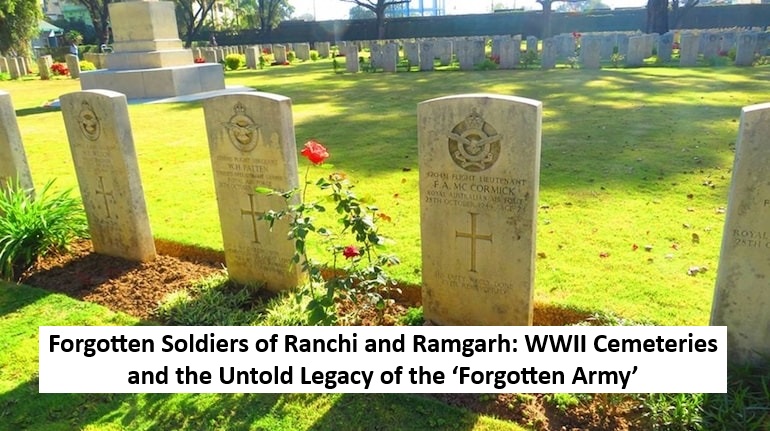
In a quiet and often overlooked part of Ranchi, lies a Commonwealth War Cemetery, the final resting place for soldiers from around the world who never returned home from World War II. Among those buried are Paulus Kachhap of Takra (Bihar), Sanda Bangor of Nigeria, Rukha of Sialkot, Sydney F. Pickett of Middlesex (UK), Alexander Sutherland of Auckland (New Zealand), and Kamal Topno of Ranchi. Though they likely never met in life, in death they share this solemn space—far removed from the major battlefronts of the global war.
Why Were WWII Soldiers in Ranchi?
The presence of foreign soldiers in Ranchi traces back to December 1941, when Japan entered WWII by attacking Southeast Asia and the Pacific. As Japanese troops advanced through Burma, then a British colony, panic spread. Civilians and British-Indian military personnel retreated into India. By May 1942, it was clear that British India itself could be under threat.
Ranchi became the headquarters of the XV Corps, led by Lieutenant General William Slim, who later commanded the famed 14th Army. In his book Defeat into Victory, Slim described Ranchi as ideal for military training due to its favorable climate and distance from distractions.
The Forgotten Army’s Global Composition
From 1942 to 1945, the 14th Army fought its way back into Burma. Only 13% of its personnel were ethnic British; the rest were primarily Indian, with about 100,000 troops from Africa, particularly Nigeria. This diverse composition led to the army being called the ‘Forgotten Army’, as its contributions were often overshadowed by Allied victories in Europe and the Pacific.
The varied nationalities in Ranchi’s war cemetery are a reflection of this unique army.
Post-War Burials and the Chinese Connection
After the war, fallen soldiers buried in remote battlefields were reinterred in designated war cemeteries. Ranchi’s site holds 704 graves, including 51 Indian soldiers, ranging from an 18-year-old sapper to a 61-year-old clerk. The most mysterious among them is Thomas Tan, listed as a soldier in the Chinese Army.
The answer to Tan’s presence lies in Ramgarh, a cantonment town near Ranchi. When Chinese troops retreated from Burma, two divisions—the 22nd and 38th—were reconstituted and trained in Ramgarh. Their training was overseen by U.S. General Joseph Stilwell, while the British funded and hosted the effort. This collaboration came at a time when China had already been at war with Japan since 1931.
Ramgarh’s Chinese Cemetery and Tragic Legacy
Over 660 Chinese soldiers who died during or after training in Ramgarh are buried in a dedicated cemetery, which also features a Buddhist temple built in 1983. While Taiwan continues to support the site, mainland China’s recent interest has added a geopolitical layer to its history.
Ramgarh’s military relevance didn’t end with WWII. It later housed training centers for the Sikh and Punjab Regiments. A tragic event occurred in 1984, when Brigadier SC Puri, who inaugurated the Buddhist temple, was killed during a mutiny following Operation Blue Star.
Legacy Fading into Silence
Today, both Ranchi and Ramgarh are peaceful. Their cemeteries serve as quiet reminders of a global war that reached India’s interior. While new soldiers train, the stories of the ‘Forgotten Army’ and international solidarity in the face of war slowly fade from memory—overshadowed by newer tragedies and challenges.
Read More: Bangladesh Unrest Intensifies as Angry Mobs Target Media Offices Following Death of Student Leader

 Share
Share



